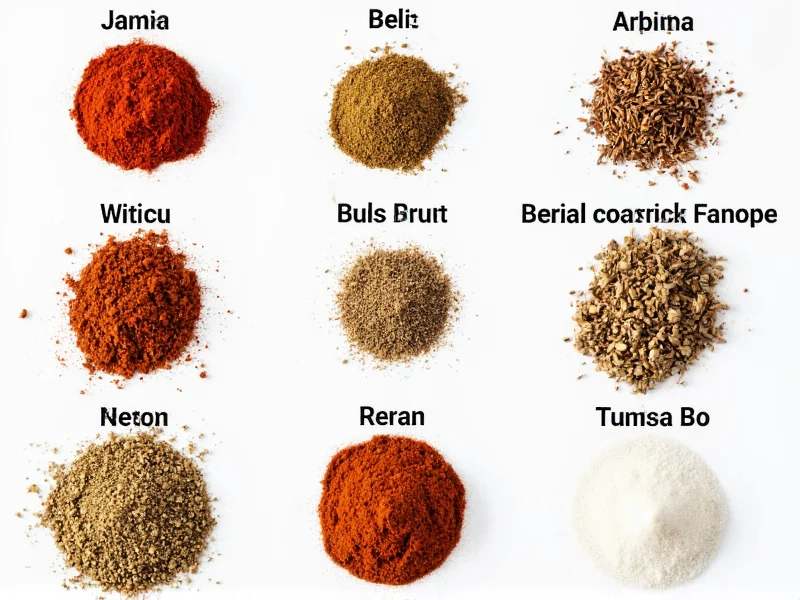Understanding spices can transform your cooking from ordinary to extraordinary. A well-designed spice chart serves as an essential kitchen reference, helping both novice and experienced cooks identify, select, and properly use the wide variety of spices available today. This guide provides a detailed visual reference of common spices with practical information you can immediately apply in your cooking.
Why Spice Charts Matter in Modern Cooking
In today's global culinary landscape, cooks have access to spices from virtually every culture. Without proper identification and usage knowledge, it's easy to misuse spices or miss opportunities to enhance dishes. A comprehensive spice chart bridges this knowledge gap by providing at-a-glance information about each spice's characteristics and applications.
The Complete Spice Reference Chart
| Spice Name | Origin | Flavor Profile | Common Uses | Pairing Recommendations |
|---|---|---|---|---|
| Cumin | Mediterranean, Middle East, India | Earthy, warm, slightly peppery with citrus notes | Curries, chili, tacos, roasted vegetables | Coriander, paprika, garlic, tomatoes |
| Paprika | Hungary, Spain, California | Mildly sweet to hot depending on variety | Goulash, deviled eggs, rubs, soups | Cumin, garlic, onion, thyme |
| Turmeric | India, Southeast Asia | Earthy, slightly bitter, peppery | Curries, rice dishes, golden milk, mustards | Ginger, cumin, coriander, black pepper |
| Cinnamon | Sri Lanka, Indonesia, China | Warm, sweet, woody | Baking, chai, Moroccan tagines, oatmeal | Nutmeg, cloves, vanilla, apples |
| Coriander | Mediterranean, Middle East, India | Citrusy, floral, slightly sweet | Curry blends, pickling, sausages, breads | Cumin, cardamom, garlic, lemon |
| Cardamom | India, Guatemala | Sweet, floral, citrusy with eucalyptus notes | Indian curries, Scandinavian baking, chai | Cinnamon, cloves, ginger, citrus |
| Nutmeg | Indonesia | Warm, sweet, slightly nutty | Béchamel sauce, mashed potatoes, baked goods | Cinnamon, cloves, allspice, dairy |
| Cloves | Indonesia, Madagascar | Intensely aromatic, sweet, slightly bitter | Pumpkin pie, mulled wine, ham glazes | Cinnamon, nutmeg, allspice, citrus |
Reading and Using Spice Charts Effectively
When using a spice chart, focus on three critical elements: visual identification, flavor characteristics, and application guidelines. Many home cooks struggle with spices because they purchase them without understanding proper storage techniques or usage amounts. A quality spice chart should include information about shelf life and storage recommendations.
For example, whole spices typically maintain their potency for 2-4 years when stored properly in airtight containers away from light and heat, while ground spices last only 6-12 months. Understanding these details prevents the common mistake of using stale spices that lack flavor impact.
Different Types of Specialized Spice Charts
While general spice charts provide broad information, specialized charts address specific culinary needs:
- Heat Level Charts - Show Scoville heat units for peppers and spicy spices
- Spice Pairing Charts - Recommend complementary spice combinations for specific proteins or vegetables
- Measurement Conversion Charts - Convert between fresh and dried herbs, whole and ground spices
- Cultural Spice Blend Charts - Detail traditional spice mixtures like garam masala, ras el hanout, and Chinese five-spice
Creating Your Personalized Spice Reference
The most valuable spice chart is one you customize based on your cooking preferences. Start with a basic chart of common spices, then add notes about your personal experiences with each spice. Document which dishes each spice works well in, your preferred brands, and any substitution notes. Over time, this becomes a tailored reference that grows with your culinary skills.
Consider including space for your own spice blend recipes, noting ratios that work well for your taste preferences. Many professional chefs maintain digital or physical spice journals that evolve as they experiment with new ingredients and techniques.
Practical Applications in Everyday Cooking
Understanding spice charts transforms how you approach recipes. Instead of blindly following ingredient lists, you can make informed substitutions based on flavor profiles. If a recipe calls for sumac and you don't have it, your spice chart might suggest a combination of lemon zest and black pepper as an alternative.
When developing your own recipes, consult your spice chart to ensure balanced flavor profiles. For instance, if creating a rub for grilled chicken, you might combine paprika for color, garlic powder for savory notes, and a touch of cayenne for heat - proportions guided by your understanding from the spice chart.
FAQ
What is the difference between a spice chart and a spice guide?
A spice chart typically presents information in a visual, tabular format showing multiple spices with their characteristics side-by-side, while a spice guide usually offers more detailed narrative descriptions of individual spices with usage recommendations and recipes.
How often should I replace spices according to spice storage charts?
Whole spices generally maintain freshness for 2-4 years when stored properly in airtight containers away from light and heat, while ground spices typically last 6-12 months. Spice charts often include visual indicators like color vibrancy and aroma strength to help determine when spices have lost potency.
Can spice charts help with dietary restrictions?
Yes, specialized spice charts can indicate which spices are suitable for specific dietary needs. For example, they might highlight naturally gluten-free spices, low-sodium options, or spices appropriate for particular cultural or religious dietary requirements.
What's the best way to organize spices using a spice chart?
Many cooks organize spices alphabetically, by cuisine type, or by frequency of use. A spice chart can help you create a logical organization system based on how you actually cook. Consider grouping spices by common usage patterns rather than strict alphabetical order for maximum kitchen efficiency.











 浙公网安备
33010002000092号
浙公网安备
33010002000092号 浙B2-20120091-4
浙B2-20120091-4